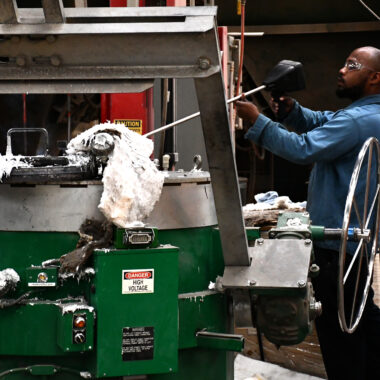Raise Your Production Line: Aluminum Casting Techniques That Deliver Results
Wiki Article
Study the Globe of Light Weight Aluminum Spreading: Recognizing the Different Techniques
Light weight aluminum spreading is an essential process in the production market, with different techniques employed to develop accurate and intricate components. Recognizing the different techniques made use of in aluminum casting can supply useful insights right into the abilities and limitations of each approach. From the traditional sand spreading method to the innovative die casting process, each method supplies special advantages depending upon the requirements of the project. Discovering these diverse techniques can offer a thorough view of the opportunities within the globe of aluminum spreading and how each strategy adds to shaping the modern-day manufacturing landscape.Sand Casting Technique
Sand casting, a widely-used technique in aluminum casting processes, entails producing mold and mildews made of compressed sand for putting molten steel. When the mold and mildew is all set, it is safely put in a flask and molten aluminum is poured right into the dental caries.After the steel has cooled and strengthened, the sand mold is escaped to expose the light weight aluminum spreading. Sand spreading permits the production of intricate forms and huge components that may be difficult or expensive to generate utilizing other approaches. It is likewise a sustainable technique as the sand can be reused and utilized several times, reducing waste in the casting process.
Permanent Mold And Mildew Method

One significant benefit of the Irreversible Mold Method is the boosted dimensional accuracy it uses. The metal mold enables tighter tolerances and better information in the final aluminum castings contrasted to sand casting approaches. This accuracy makes it a recommended option for applications where tight dimensional control is critical, such as in the aerospace and automotive industries.

Pass Away Casting Refine

Investment Casting Method
Using a precision casting method, over at this website Financial investment Casting Approach involves creating detailed light weight aluminum elements by pouring molten steel right into a ceramic mold and mildew. This procedure, likewise referred to as lost-wax casting, begins with the development of a wax pattern of the preferred component. This wax pattern is then coated with a ceramic material to create a covering. When the ceramic shell is set, it is warmed to get rid of the wax, leaving a hollow ceramic mold.Financial investment spreading is typically utilized for producing parts in industries where tight tolerances and complex designs are required, such as aerospace, vehicle, and medical devices. The convenience and precision of the Investment Casting Technique make it a beneficial technique in the globe of light weight aluminum spreading.
Lost Foam Casting Method
Having actually discovered the detailed precision of Investment Casting Approach, the emphasis currently moves to the ingenious technique of Lost Foam Casting in aluminum component production. Lost Foam Spreading, likewise known as evaporative pattern spreading, is a modern-day strategy where a foam pattern of the preferred part is created and after that covered with a refractory product.Furthermore, Lost Foam Spreading is an economical procedure as it minimizes the demand for cores and enables for the production of light-weight components. In spite of its benefits, Lost Foam Casting calls for mindful control of the spreading procedure to avoid issues and guarantee high quality parts.
Conclusion
Finally, aluminum casting uses a selection of techniques such as sand spreading, permanent mold strategy, die spreading, investment spreading, and shed foam spreading. Each method has its own benefits and applications, making light weight aluminum casting a flexible and commonly made use of procedure in various markets. Recognizing the distinctions between these techniques is critical in picking one of the most suitable casting method for specific production requirements.Sand casting, a widely-used technique in light weight aluminum spreading processes, includes producing molds made of compressed sand for putting liquified steel. aluminum casting.The Irreversible Mold Technique, like sand spreading, is an additional common approach used in light weight aluminum spreading procedures, supplying distinctive advantages in terms of mold reusability and dimensional accuracy. The metal mold permits for tighter resistances and better blog information in the last light weight aluminum spreadings contrasted to sand casting techniques. The two main types of die casting are cool chamber pass away spreading and hot chamber die casting, each suitable for different kinds of light weight aluminum alloys.In verdict, aluminum casting offers a variety of approaches such as sand spreading, long-term mold technique, die casting, investment spreading, and shed foam casting
Report this wiki page